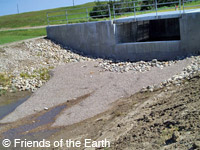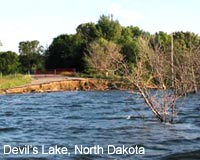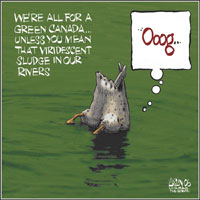
|
Water Fact Sheets Manitoba Floods |
Trans-Boundary Initiatives |
Top |
View the Devils Lake Water Diversion Project Timeline
The Devils Lake Outlet Project The Devils Lake outlet is a US$28 million project to pump excess water from Devils Lake into the Sheyenne River, which flows into the Red River, across the border into Canada, and then to Lake Winnipeg and Hudson's Bay.
The Devils Lake outlet is a US$28 million project to pump excess water from Devils Lake into the Sheyenne River, which flows into the Red River, across the border into Canada, and then to Lake Winnipeg and Hudson's Bay.The Government of Manitoba, in particular Premier Gary Doer, has made this issue a primary focus and a great deal of attention has been generated in the media. Manitoba is concerned about the possible ecological and economic risks of transferring water into Manitoba's Red River system from a lake that is land-locked and polluted. North Dakota sees the outlet as a solution to the flooding caused by the rising lake. The Devils Lake outlet is scheduled to become operational early in August 2005.  Download Water Issue Fact Sheet #2 - The Devils Lake Outlet Project Download Water Issue Fact Sheet #2 - The Devils Lake Outlet Project  (PDF) (PDF)View Manitoba Wildlands news items on Devils Lake: Great Lakes Mayor Back Manitoba - May 31, 2005  Citizen Action on Proposed Devils Lake Outlet - May 12, 2005  Devils Lake Outlet Hangs in the Balance - April 28, 2005 
 Politicians on both sides of the border are praising an 'agreement' reached Friday August 5, 2005 that allows North Dakota to proceed with its plan to divert water from Devils Lake into the Sheyenne River and into the Red River. Critics of the Devils Lake Outlet project are not convinced that the deal is a good one for Canada and Manitoba. Politicians on both sides of the border are praising an 'agreement' reached Friday August 5, 2005 that allows North Dakota to proceed with its plan to divert water from Devils Lake into the Sheyenne River and into the Red River. Critics of the Devils Lake Outlet project are not convinced that the deal is a good one for Canada and Manitoba.In the interim, the water from Devils Lake will begin to flow through an existing rock and gravel filter, but the 'agreement' includes co-operation on a downstream monitoring program and a commitment to build a more sophisticated filtration system for the outlet. Officials from the governments of North Dakota, Minnesota, Manitoba, the United States and Canada say they will also explore ways to ensure harmful water organisms aren't transferred to Canada. The water in Devils Lake contains high levels of salts, arsenic, boron, mercury and phosphorus. In an interview, Manitoba Premier Gary Doer, who has crusaded to halt the Devils Lake project and secure a referral of the project to the International Joint Commission for review, conceded that "It's not 100 per cent perfect, but it's a lot of improvement from where we were a few months ago when we had nothing. We've got major, major improvements to keep our water as safe as we can." However, those non-governmental groups that have been pushing for the environmental concerns about the project to be addressed, as well as some politicians, have outright criticized the deal or at least conceded its weaknesses. Beatrice Olivastri, chief executive of Friends of the Earth (FOE), questioned how the deal will be enforced and how disagreements will be handled. FOE has campaigned for a referral to the IJC. While indicating that any project should be subject to the polluter pays principal, she said that on the threat to Canadian waters and fishers the 'deal' does nothing to safeguard Manitoba and Canada's environment today. Frank McKenna, Canada's ambassador to the United States, who handled Canada - US negotiations last week, has admitted that the 'agreement' is not "legally binding" and will require more negotiation before it is completed.  Download Manitoba Wildlands' Summary and Critique - Devils Lake 'Agreement' Download Manitoba Wildlands' Summary and Critique - Devils Lake 'Agreement'  (PDF) (PDF)View August 5, 2005 Government of Manitoba press release View Office of the Governor of North Dakota's August 3, 2005 statement and August 5, 2005 press release View Grand Forks Herald articles on Devils Lake: August 6 &, August 9, 2005 View previous Manitoba Wildlands news items regarding Devils Lake by going to our News Archives page and selecting WATER |
|||||
Devils Lake Study ReleasedThe joint study agreed to by North Dakota to allay Canadian concerns regarding invasive species and foreign biota flowing from Devils Lake north to Lake Winnipeg was released on November 15, 2005.The study indicates that none of the 12 invasive species Manitoba identified as being of concern were found in Devils Lake. |
 By Terry Aislin, Montreal Gazette Large Image |
||||
|
The tests did, however reveal biota of potential concern that have not been previously found in Lake Winnipeg. Four types of blue-green algae not found in Lake Winnipeg were identified in Devils Lake. These algae are potential species of concern to Manitoba as they are capable of producing toxins. Three fish parasites were found that are potential species of concern for Manitoba as they are not known to be present in Lake Winnipeg or the Hudson Bay basin and all have the capability to impact fish. Two of the parasites (Gyrodactylus hoffmani and Epistylis) had been found previously in Devils Lake while a third (Trichodina) was discovered during this study. The multi-agency study was overseen by the White House's Council on Environmental Quality. Manitoba also produced its own report on the study. The study also included additional work on fish pathogens and parasites as well as a study of the phytoplankton, zooplankton and the bottom-dwelling invertebrate community in Devils and Stump lakes. View November 15, 2005 Manitoba Water Stewardship press release View November 16, 2005 Governor of North Dakota press release  Download White House's Council on Environmental Quality report Survey of Specific Fish Pathogens in Free-Ranging Fish from Devils Lake (PDF) Download White House's Council on Environmental Quality report Survey of Specific Fish Pathogens in Free-Ranging Fish from Devils Lake (PDF) Download November 15, 2005 Winnipeg Free Press article (DOC) Download November 15, 2005 Winnipeg Free Press article (DOC) Download November 16, 2005 Winnipeg Free Press article (DOC) Download November 16, 2005 Winnipeg Free Press article (DOC)Sources: Government of Manitoba, Governor of North Dakota, Winnipeg Free Press
 On March 2, 2007, North Dakota's District Court heard arguments in Manitoba's challenge of the North Dakota Department of Health decision to modify the Devils Lake outlet operating permit.
On March 2, 2007, North Dakota's District Court heard arguments in Manitoba's challenge of the North Dakota Department of Health decision to modify the Devils Lake outlet operating permit.The legal challenge was filed September 2006 by the Manitoba government, People to Save the Sheyenne River, the Peterson Coulee Outlet Association, and the US National Wildlife Federation. In August 2006, North Dakota's Department of Health modified the Devils Lake operating permit to allow higher levels of sulfates to be discharged from the lake to the Sheyenne River and expanded the time period each year during which the outlet can be operated. The Devils Lake outlet did not operate in 2006 because sulphate levels in the adjacent Sheyenne River were above state guidelines. Raising the allowable limit for sulphate, and extending the operating period, will increase the amount of water discharged from Devils Lake. Water Stewardship Minister Christine Melnick says this increases the risk that foreign biota will be transferred into Manitoba. Manitoba's legal challenge is based on the assertion that North Dakota failed to demonstrate adequate cause for the permit modifications and failed to conduct an anti-degradation review as required for a major permit modification. A decision by the Court regarding Manitoba's appeal is expected by the end of April 2007. View March 2, 2007 Government of Manitoba press release Source: Government of Manitoba
Devils Lake Update - June 2007 Outlet Operation,
North Dakota opened the Devils Lake outlet gates for the first time in 2007 June 11, 2007, at 2:00pm. Water began flowing, despite the promised new, sophisticated filter not being installed, and the first year of International Joint Commission (IJC) testing results not being public. The Manitoba government is taking its appeal of the decision to weaken the outlets environmental standards to the North Dakota Supreme Court. |
|||||
Auditor General Petitioned on Devils Lake Outlet |
Top |
 Friends of the Earth Canada and the Manitoba Chambers of Commerce have joined together to petition the Auditor General of Canada to ensure Canadian politicians and officials protect Canadian waters against the impacts associated with the Devils Lake Outlet.
Friends of the Earth Canada and the Manitoba Chambers of Commerce have joined together to petition the Auditor General of Canada to ensure Canadian politicians and officials protect Canadian waters against the impacts associated with the Devils Lake Outlet.The Petition submitted June 12, 2008 calls for public disclosure by Canada's Ministers of the Environment and Foreign Affairs on matters agreed to by Canada and the US in the August 2005 Multi-layered Safeguard Agreement.
Under the 2005 Agreement, Canada and the US were expected to work together on the construction of an advanced filtration/disinfection system, a monitoring system for water quality and aquatic nuisance species and take immediate measures to prevent the spread of any aquatic nuisance species that pose significant risk to the Basin. Although almost three years have passed, the advanced filtration system is still not operational and there is no firm timetable as to when construction will be complete.
Officials are set to reissue a permit to continue operating the Devils Lake outlet with only a rudimentary gravel filter in place - it will allow unaltered operation of the outlet until 2013.
The Petitioners want a public explanation as to measures being taken to ensure the advanced filtration system is constructed and the 2005 agreement upheld. If the advanced filtration system is not going to be constructed, the Petitioners want to know what consideration is being given to permanently shutting down the Outlet.
View June 12, 2008 Friends of the Earth (FOE) press releaseView June 12, 2008 petition to the Auditor General, federal Environment Minister, and Minister of Foreign Affairs by FOE Canada and Manitoba Chambers of Commerce (PDF)
View June 16, 2008 KXnet.com North Dakota News Network article
View the Devils Lake Water Diversion Project Timeline
 2002-2014
2002-2014


 Friends of the Earth Canada has written an open letter to Prime Minister Harper, President George Bush, Premier Gary Doer, Manitoba, North Dakota Governor John Hoeven and Minnesota Governor Tim Pawlenty, calling the leaders to account for their commitments to make public first year IJC testing results, and to report on installation of the advanced filter or disinfection system.
Friends of the Earth Canada has written an open letter to Prime Minister Harper, President George Bush, Premier Gary Doer, Manitoba, North Dakota Governor John Hoeven and Minnesota Governor Tim Pawlenty, calling the leaders to account for their commitments to make public first year IJC testing results, and to report on installation of the advanced filter or disinfection system.